Business Environment: Governance and PESTEL Analysis of Tesco Plc
VerifiedAdded on 2023/01/10
|12
|3258
|49
AI Summary
This report provides an overview of the governance and structure of Tesco Plc. It also evaluates the importance of conducting PESTEL analysis for the organization. The PESTEL factors influencing Tesco's external environment are discussed in detail. Subject: Business Environment, Course Code: N/A, Course Name: N/A, College/University: N/A, Document Type: Report, Assignment Type: N/A
Contribute Materials
Your contribution can guide someone’s learning journey. Share your
documents today.
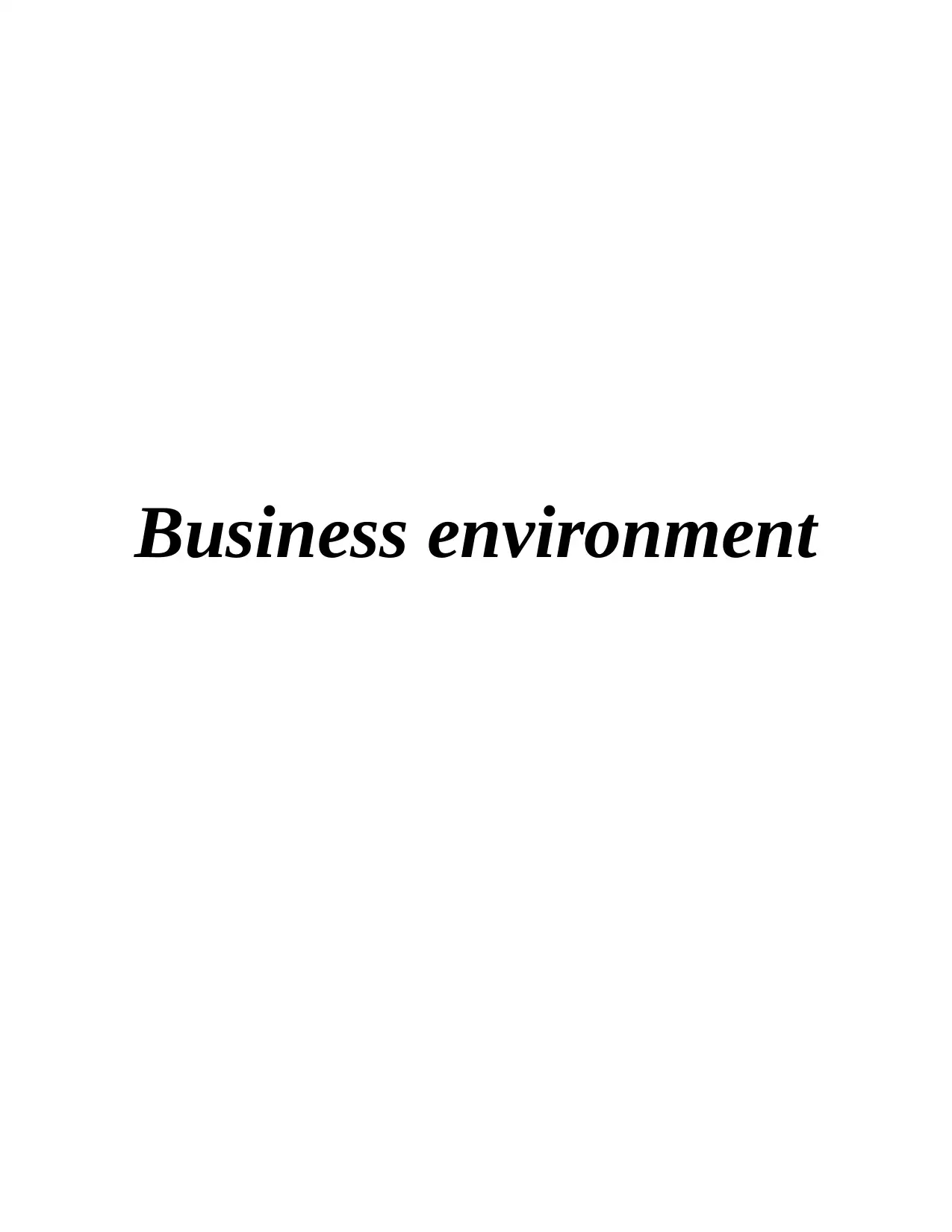
Business environment
Secure Best Marks with AI Grader
Need help grading? Try our AI Grader for instant feedback on your assignments.

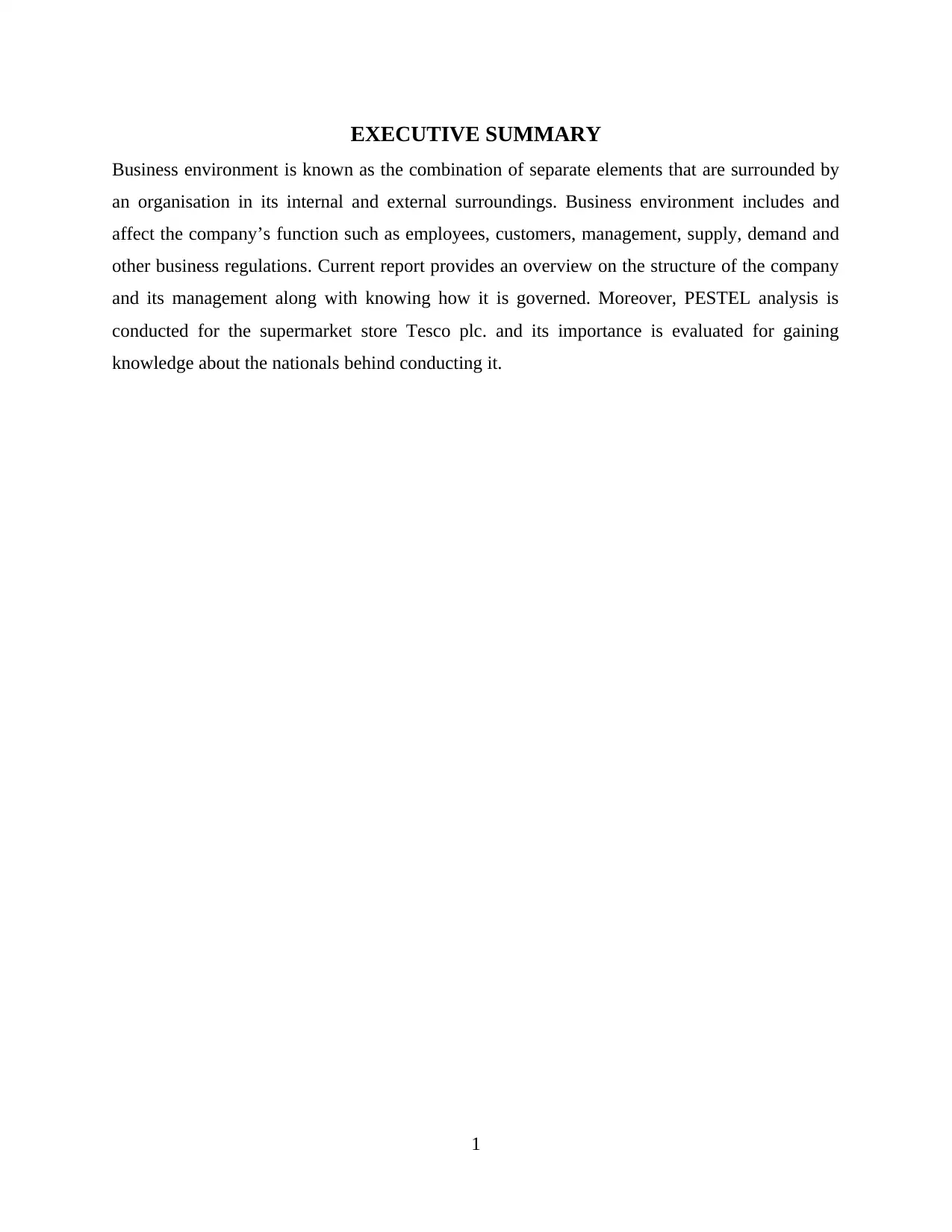
EXECUTIVE SUMMARY
Business environment is known as the combination of separate elements that are surrounded by
an organisation in its internal and external surroundings. Business environment includes and
affect the company’s function such as employees, customers, management, supply, demand and
other business regulations. Current report provides an overview on the structure of the company
and its management along with knowing how it is governed. Moreover, PESTEL analysis is
conducted for the supermarket store Tesco plc. and its importance is evaluated for gaining
knowledge about the nationals behind conducting it.
1
Business environment is known as the combination of separate elements that are surrounded by
an organisation in its internal and external surroundings. Business environment includes and
affect the company’s function such as employees, customers, management, supply, demand and
other business regulations. Current report provides an overview on the structure of the company
and its management along with knowing how it is governed. Moreover, PESTEL analysis is
conducted for the supermarket store Tesco plc. and its importance is evaluated for gaining
knowledge about the nationals behind conducting it.
1
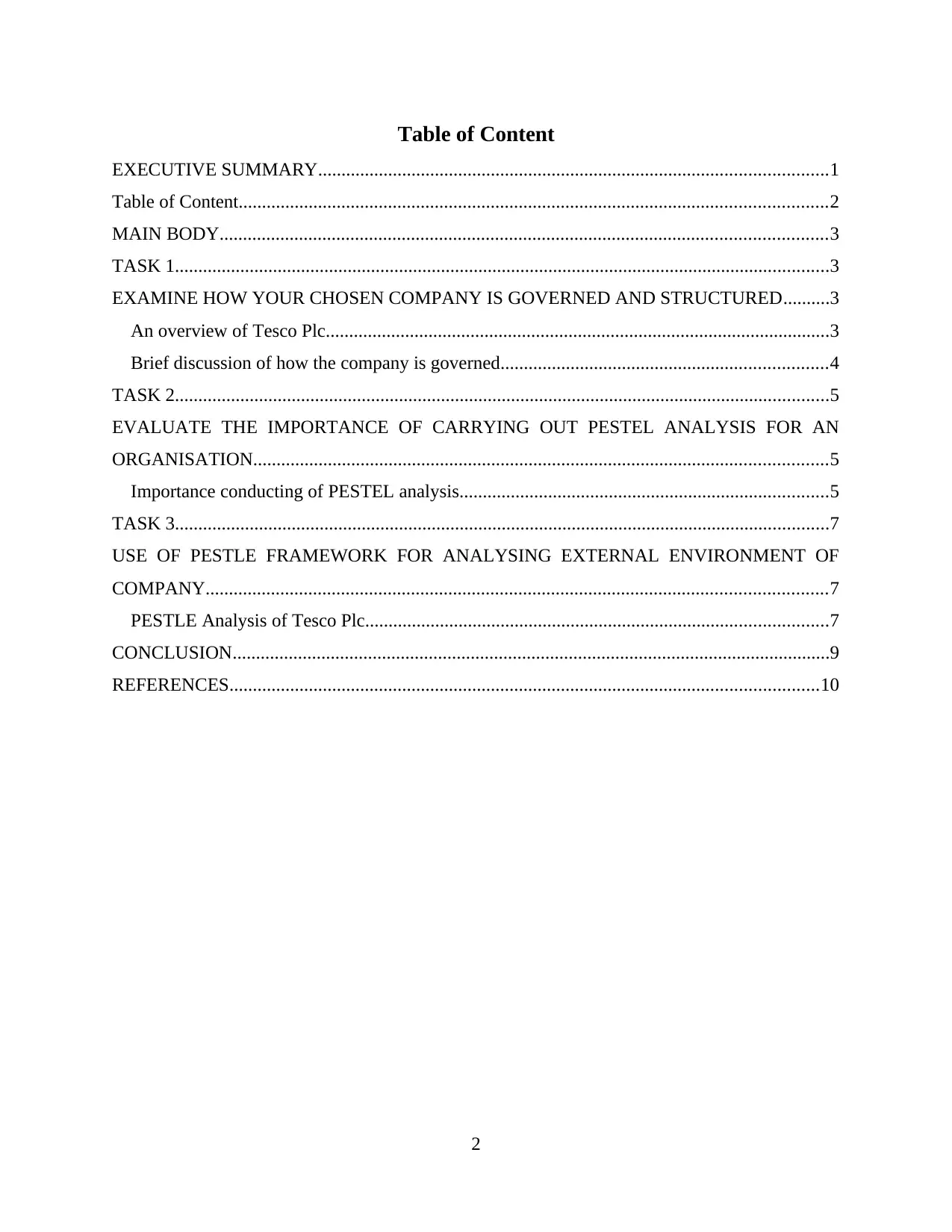
Table of Content
EXECUTIVE SUMMARY.............................................................................................................1
Table of Content..............................................................................................................................2
MAIN BODY..................................................................................................................................3
TASK 1............................................................................................................................................3
EXAMINE HOW YOUR CHOSEN COMPANY IS GOVERNED AND STRUCTURED..........3
An overview of Tesco Plc............................................................................................................3
Brief discussion of how the company is governed......................................................................4
TASK 2............................................................................................................................................5
EVALUATE THE IMPORTANCE OF CARRYING OUT PESTEL ANALYSIS FOR AN
ORGANISATION...........................................................................................................................5
Importance conducting of PESTEL analysis...............................................................................5
TASK 3............................................................................................................................................7
USE OF PESTLE FRAMEWORK FOR ANALYSING EXTERNAL ENVIRONMENT OF
COMPANY.....................................................................................................................................7
PESTLE Analysis of Tesco Plc...................................................................................................7
CONCLUSION................................................................................................................................9
REFERENCES..............................................................................................................................10
2
EXECUTIVE SUMMARY.............................................................................................................1
Table of Content..............................................................................................................................2
MAIN BODY..................................................................................................................................3
TASK 1............................................................................................................................................3
EXAMINE HOW YOUR CHOSEN COMPANY IS GOVERNED AND STRUCTURED..........3
An overview of Tesco Plc............................................................................................................3
Brief discussion of how the company is governed......................................................................4
TASK 2............................................................................................................................................5
EVALUATE THE IMPORTANCE OF CARRYING OUT PESTEL ANALYSIS FOR AN
ORGANISATION...........................................................................................................................5
Importance conducting of PESTEL analysis...............................................................................5
TASK 3............................................................................................................................................7
USE OF PESTLE FRAMEWORK FOR ANALYSING EXTERNAL ENVIRONMENT OF
COMPANY.....................................................................................................................................7
PESTLE Analysis of Tesco Plc...................................................................................................7
CONCLUSION................................................................................................................................9
REFERENCES..............................................................................................................................10
2
Secure Best Marks with AI Grader
Need help grading? Try our AI Grader for instant feedback on your assignments.
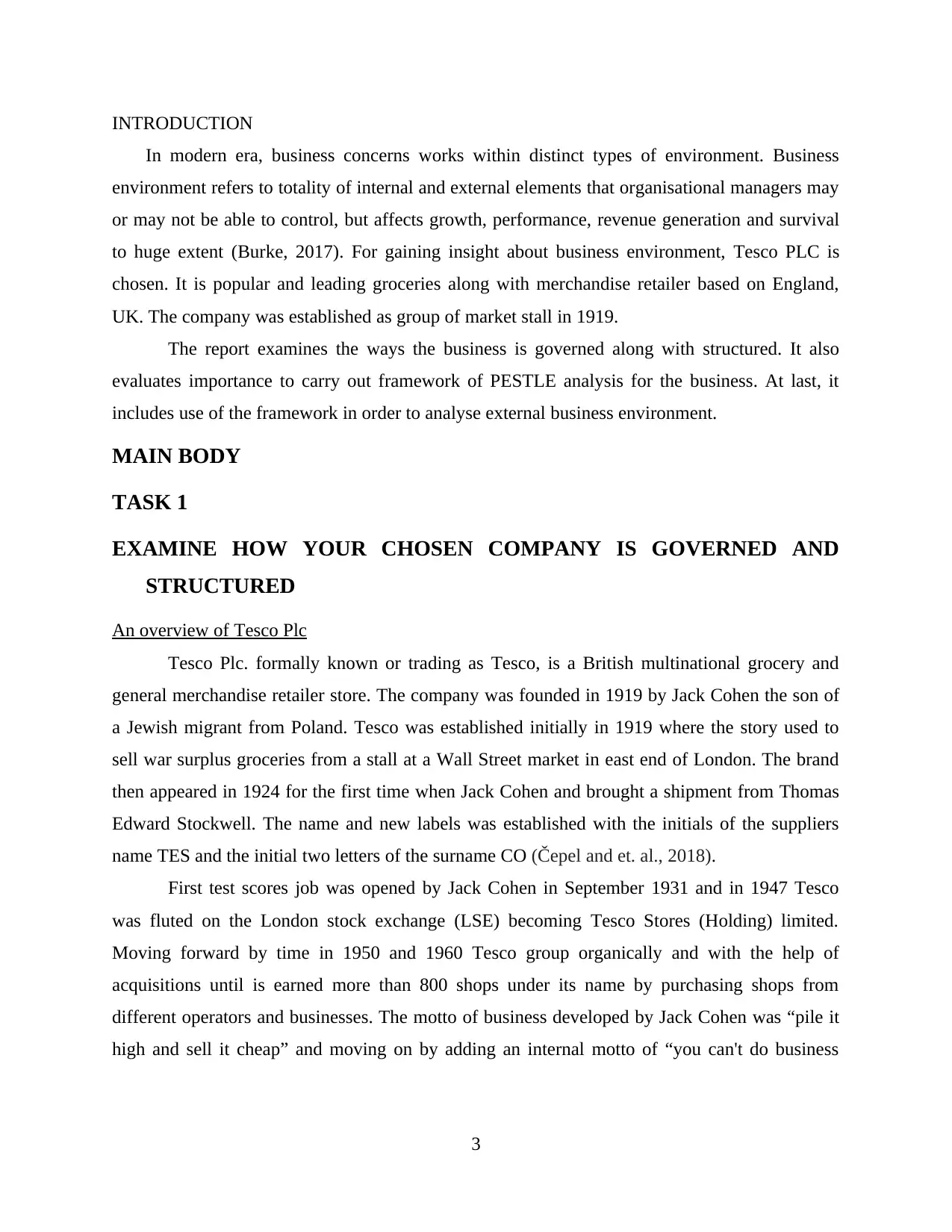
INTRODUCTION
In modern era, business concerns works within distinct types of environment. Business
environment refers to totality of internal and external elements that organisational managers may
or may not be able to control, but affects growth, performance, revenue generation and survival
to huge extent (Burke, 2017). For gaining insight about business environment, Tesco PLC is
chosen. It is popular and leading groceries along with merchandise retailer based on England,
UK. The company was established as group of market stall in 1919.
The report examines the ways the business is governed along with structured. It also
evaluates importance to carry out framework of PESTLE analysis for the business. At last, it
includes use of the framework in order to analyse external business environment.
MAIN BODY
TASK 1
EXAMINE HOW YOUR CHOSEN COMPANY IS GOVERNED AND
STRUCTURED
An overview of Tesco Plc
Tesco Plc. formally known or trading as Tesco, is a British multinational grocery and
general merchandise retailer store. The company was founded in 1919 by Jack Cohen the son of
a Jewish migrant from Poland. Tesco was established initially in 1919 where the story used to
sell war surplus groceries from a stall at a Wall Street market in east end of London. The brand
then appeared in 1924 for the first time when Jack Cohen and brought a shipment from Thomas
Edward Stockwell. The name and new labels was established with the initials of the suppliers
name TES and the initial two letters of the surname CO (Čepel and et. al., 2018).
First test scores job was opened by Jack Cohen in September 1931 and in 1947 Tesco
was fluted on the London stock exchange (LSE) becoming Tesco Stores (Holding) limited.
Moving forward by time in 1950 and 1960 Tesco group organically and with the help of
acquisitions until is earned more than 800 shops under its name by purchasing shops from
different operators and businesses. The motto of business developed by Jack Cohen was “pile it
high and sell it cheap” and moving on by adding an internal motto of “you can't do business
3
In modern era, business concerns works within distinct types of environment. Business
environment refers to totality of internal and external elements that organisational managers may
or may not be able to control, but affects growth, performance, revenue generation and survival
to huge extent (Burke, 2017). For gaining insight about business environment, Tesco PLC is
chosen. It is popular and leading groceries along with merchandise retailer based on England,
UK. The company was established as group of market stall in 1919.
The report examines the ways the business is governed along with structured. It also
evaluates importance to carry out framework of PESTLE analysis for the business. At last, it
includes use of the framework in order to analyse external business environment.
MAIN BODY
TASK 1
EXAMINE HOW YOUR CHOSEN COMPANY IS GOVERNED AND
STRUCTURED
An overview of Tesco Plc
Tesco Plc. formally known or trading as Tesco, is a British multinational grocery and
general merchandise retailer store. The company was founded in 1919 by Jack Cohen the son of
a Jewish migrant from Poland. Tesco was established initially in 1919 where the story used to
sell war surplus groceries from a stall at a Wall Street market in east end of London. The brand
then appeared in 1924 for the first time when Jack Cohen and brought a shipment from Thomas
Edward Stockwell. The name and new labels was established with the initials of the suppliers
name TES and the initial two letters of the surname CO (Čepel and et. al., 2018).
First test scores job was opened by Jack Cohen in September 1931 and in 1947 Tesco
was fluted on the London stock exchange (LSE) becoming Tesco Stores (Holding) limited.
Moving forward by time in 1950 and 1960 Tesco group organically and with the help of
acquisitions until is earned more than 800 shops under its name by purchasing shops from
different operators and businesses. The motto of business developed by Jack Cohen was “pile it
high and sell it cheap” and moving on by adding an internal motto of “you can't do business
3
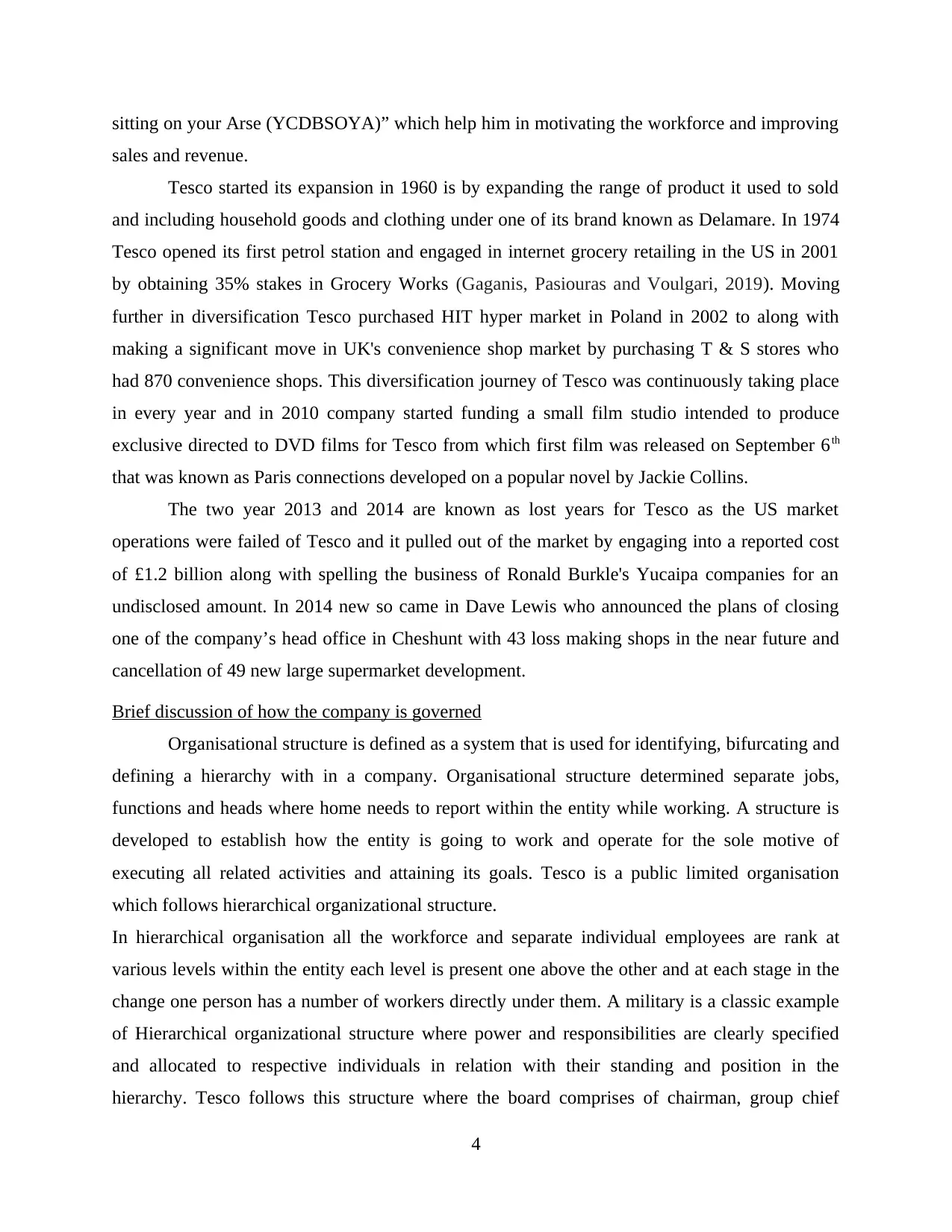
sitting on your Arse (YCDBSOYA)” which help him in motivating the workforce and improving
sales and revenue.
Tesco started its expansion in 1960 is by expanding the range of product it used to sold
and including household goods and clothing under one of its brand known as Delamare. In 1974
Tesco opened its first petrol station and engaged in internet grocery retailing in the US in 2001
by obtaining 35% stakes in Grocery Works (Gaganis, Pasiouras and Voulgari, 2019). Moving
further in diversification Tesco purchased HIT hyper market in Poland in 2002 to along with
making a significant move in UK's convenience shop market by purchasing T & S stores who
had 870 convenience shops. This diversification journey of Tesco was continuously taking place
in every year and in 2010 company started funding a small film studio intended to produce
exclusive directed to DVD films for Tesco from which first film was released on September 6th
that was known as Paris connections developed on a popular novel by Jackie Collins.
The two year 2013 and 2014 are known as lost years for Tesco as the US market
operations were failed of Tesco and it pulled out of the market by engaging into a reported cost
of £1.2 billion along with spelling the business of Ronald Burkle's Yucaipa companies for an
undisclosed amount. In 2014 new so came in Dave Lewis who announced the plans of closing
one of the company’s head office in Cheshunt with 43 loss making shops in the near future and
cancellation of 49 new large supermarket development.
Brief discussion of how the company is governed
Organisational structure is defined as a system that is used for identifying, bifurcating and
defining a hierarchy with in a company. Organisational structure determined separate jobs,
functions and heads where home needs to report within the entity while working. A structure is
developed to establish how the entity is going to work and operate for the sole motive of
executing all related activities and attaining its goals. Tesco is a public limited organisation
which follows hierarchical organizational structure.
In hierarchical organisation all the workforce and separate individual employees are rank at
various levels within the entity each level is present one above the other and at each stage in the
change one person has a number of workers directly under them. A military is a classic example
of Hierarchical organizational structure where power and responsibilities are clearly specified
and allocated to respective individuals in relation with their standing and position in the
hierarchy. Tesco follows this structure where the board comprises of chairman, group chief
4
sales and revenue.
Tesco started its expansion in 1960 is by expanding the range of product it used to sold
and including household goods and clothing under one of its brand known as Delamare. In 1974
Tesco opened its first petrol station and engaged in internet grocery retailing in the US in 2001
by obtaining 35% stakes in Grocery Works (Gaganis, Pasiouras and Voulgari, 2019). Moving
further in diversification Tesco purchased HIT hyper market in Poland in 2002 to along with
making a significant move in UK's convenience shop market by purchasing T & S stores who
had 870 convenience shops. This diversification journey of Tesco was continuously taking place
in every year and in 2010 company started funding a small film studio intended to produce
exclusive directed to DVD films for Tesco from which first film was released on September 6th
that was known as Paris connections developed on a popular novel by Jackie Collins.
The two year 2013 and 2014 are known as lost years for Tesco as the US market
operations were failed of Tesco and it pulled out of the market by engaging into a reported cost
of £1.2 billion along with spelling the business of Ronald Burkle's Yucaipa companies for an
undisclosed amount. In 2014 new so came in Dave Lewis who announced the plans of closing
one of the company’s head office in Cheshunt with 43 loss making shops in the near future and
cancellation of 49 new large supermarket development.
Brief discussion of how the company is governed
Organisational structure is defined as a system that is used for identifying, bifurcating and
defining a hierarchy with in a company. Organisational structure determined separate jobs,
functions and heads where home needs to report within the entity while working. A structure is
developed to establish how the entity is going to work and operate for the sole motive of
executing all related activities and attaining its goals. Tesco is a public limited organisation
which follows hierarchical organizational structure.
In hierarchical organisation all the workforce and separate individual employees are rank at
various levels within the entity each level is present one above the other and at each stage in the
change one person has a number of workers directly under them. A military is a classic example
of Hierarchical organizational structure where power and responsibilities are clearly specified
and allocated to respective individuals in relation with their standing and position in the
hierarchy. Tesco follows this structure where the board comprises of chairman, group chief
4
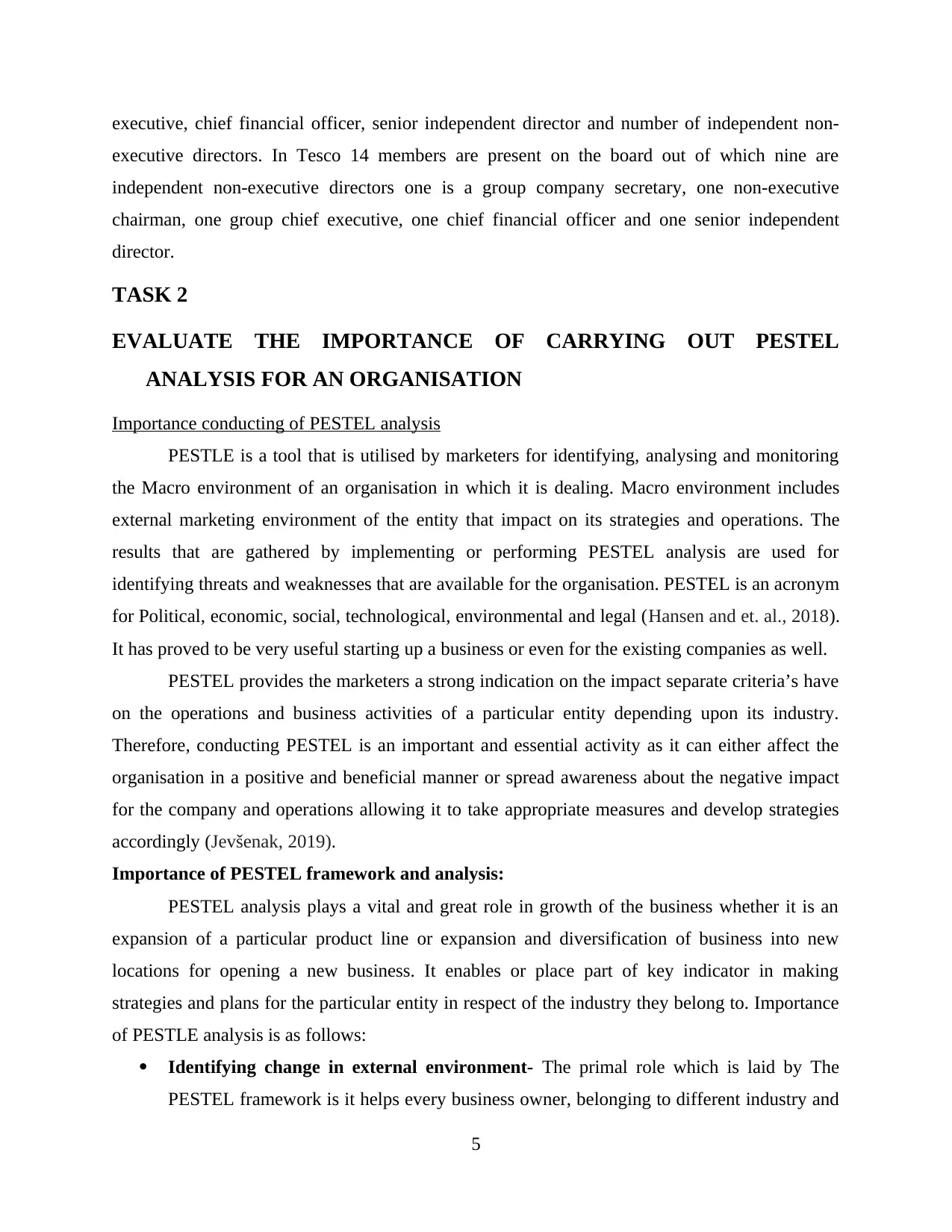
executive, chief financial officer, senior independent director and number of independent non-
executive directors. In Tesco 14 members are present on the board out of which nine are
independent non-executive directors one is a group company secretary, one non-executive
chairman, one group chief executive, one chief financial officer and one senior independent
director.
TASK 2
EVALUATE THE IMPORTANCE OF CARRYING OUT PESTEL
ANALYSIS FOR AN ORGANISATION
Importance conducting of PESTEL analysis
PESTLE is a tool that is utilised by marketers for identifying, analysing and monitoring
the Macro environment of an organisation in which it is dealing. Macro environment includes
external marketing environment of the entity that impact on its strategies and operations. The
results that are gathered by implementing or performing PESTEL analysis are used for
identifying threats and weaknesses that are available for the organisation. PESTEL is an acronym
for Political, economic, social, technological, environmental and legal (Hansen and et. al., 2018).
It has proved to be very useful starting up a business or even for the existing companies as well.
PESTEL provides the marketers a strong indication on the impact separate criteria’s have
on the operations and business activities of a particular entity depending upon its industry.
Therefore, conducting PESTEL is an important and essential activity as it can either affect the
organisation in a positive and beneficial manner or spread awareness about the negative impact
for the company and operations allowing it to take appropriate measures and develop strategies
accordingly (Jevšenak, 2019).
Importance of PESTEL framework and analysis:
PESTEL analysis plays a vital and great role in growth of the business whether it is an
expansion of a particular product line or expansion and diversification of business into new
locations for opening a new business. It enables or place part of key indicator in making
strategies and plans for the particular entity in respect of the industry they belong to. Importance
of PESTLE analysis is as follows:
Identifying change in external environment- The primal role which is laid by The
PESTEL framework is it helps every business owner, belonging to different industry and
5
executive directors. In Tesco 14 members are present on the board out of which nine are
independent non-executive directors one is a group company secretary, one non-executive
chairman, one group chief executive, one chief financial officer and one senior independent
director.
TASK 2
EVALUATE THE IMPORTANCE OF CARRYING OUT PESTEL
ANALYSIS FOR AN ORGANISATION
Importance conducting of PESTEL analysis
PESTLE is a tool that is utilised by marketers for identifying, analysing and monitoring
the Macro environment of an organisation in which it is dealing. Macro environment includes
external marketing environment of the entity that impact on its strategies and operations. The
results that are gathered by implementing or performing PESTEL analysis are used for
identifying threats and weaknesses that are available for the organisation. PESTEL is an acronym
for Political, economic, social, technological, environmental and legal (Hansen and et. al., 2018).
It has proved to be very useful starting up a business or even for the existing companies as well.
PESTEL provides the marketers a strong indication on the impact separate criteria’s have
on the operations and business activities of a particular entity depending upon its industry.
Therefore, conducting PESTEL is an important and essential activity as it can either affect the
organisation in a positive and beneficial manner or spread awareness about the negative impact
for the company and operations allowing it to take appropriate measures and develop strategies
accordingly (Jevšenak, 2019).
Importance of PESTEL framework and analysis:
PESTEL analysis plays a vital and great role in growth of the business whether it is an
expansion of a particular product line or expansion and diversification of business into new
locations for opening a new business. It enables or place part of key indicator in making
strategies and plans for the particular entity in respect of the industry they belong to. Importance
of PESTLE analysis is as follows:
Identifying change in external environment- The primal role which is laid by The
PESTEL framework is it helps every business owner, belonging to different industry and
5
Paraphrase This Document
Need a fresh take? Get an instant paraphrase of this document with our AI Paraphraser
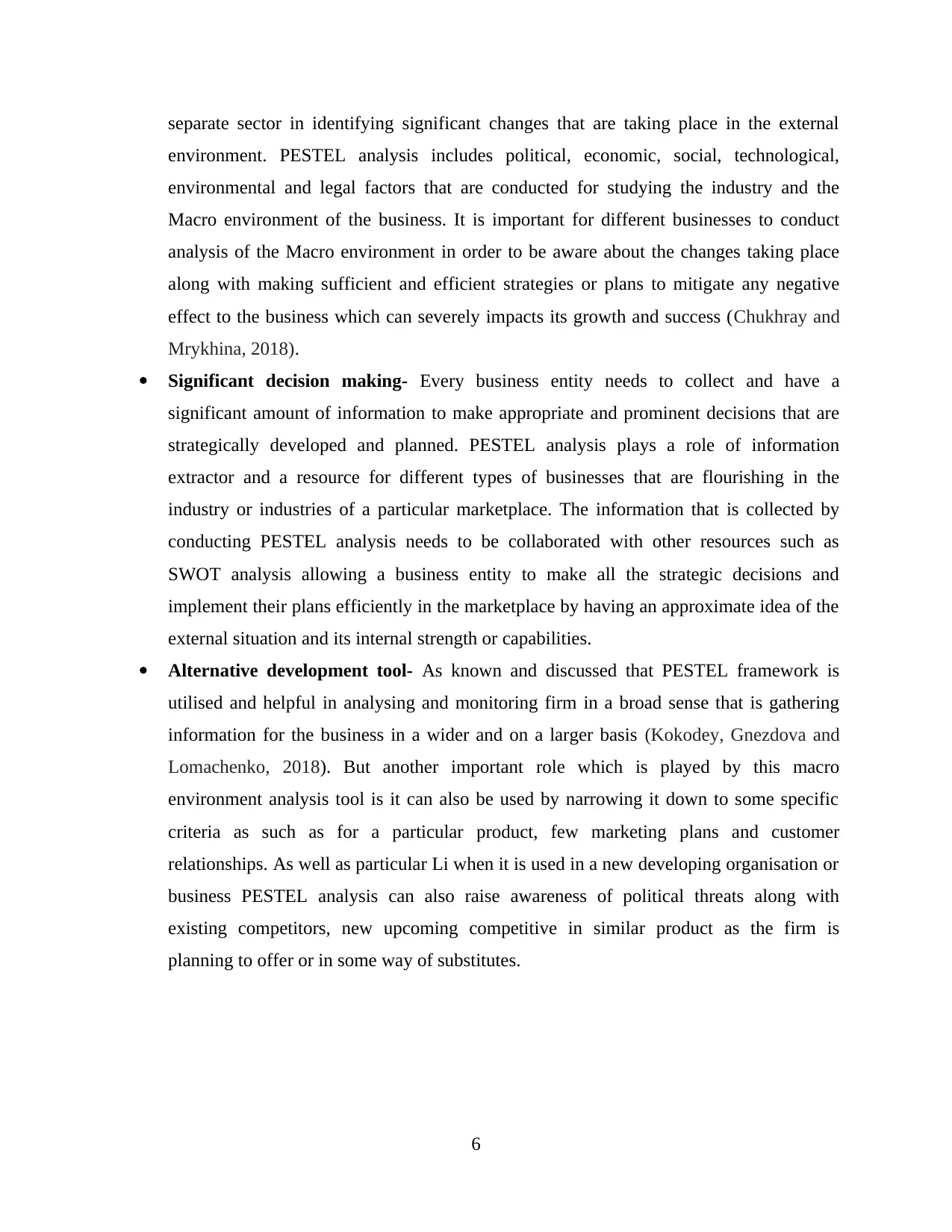
separate sector in identifying significant changes that are taking place in the external
environment. PESTEL analysis includes political, economic, social, technological,
environmental and legal factors that are conducted for studying the industry and the
Macro environment of the business. It is important for different businesses to conduct
analysis of the Macro environment in order to be aware about the changes taking place
along with making sufficient and efficient strategies or plans to mitigate any negative
effect to the business which can severely impacts its growth and success (Chukhray and
Mrykhina, 2018).
Significant decision making- Every business entity needs to collect and have a
significant amount of information to make appropriate and prominent decisions that are
strategically developed and planned. PESTEL analysis plays a role of information
extractor and a resource for different types of businesses that are flourishing in the
industry or industries of a particular marketplace. The information that is collected by
conducting PESTEL analysis needs to be collaborated with other resources such as
SWOT analysis allowing a business entity to make all the strategic decisions and
implement their plans efficiently in the marketplace by having an approximate idea of the
external situation and its internal strength or capabilities.
Alternative development tool- As known and discussed that PESTEL framework is
utilised and helpful in analysing and monitoring firm in a broad sense that is gathering
information for the business in a wider and on a larger basis (Kokodey, Gnezdova and
Lomachenko, 2018). But another important role which is played by this macro
environment analysis tool is it can also be used by narrowing it down to some specific
criteria as such as for a particular product, few marketing plans and customer
relationships. As well as particular Li when it is used in a new developing organisation or
business PESTEL analysis can also raise awareness of political threats along with
existing competitors, new upcoming competitive in similar product as the firm is
planning to offer or in some way of substitutes.
6
environment. PESTEL analysis includes political, economic, social, technological,
environmental and legal factors that are conducted for studying the industry and the
Macro environment of the business. It is important for different businesses to conduct
analysis of the Macro environment in order to be aware about the changes taking place
along with making sufficient and efficient strategies or plans to mitigate any negative
effect to the business which can severely impacts its growth and success (Chukhray and
Mrykhina, 2018).
Significant decision making- Every business entity needs to collect and have a
significant amount of information to make appropriate and prominent decisions that are
strategically developed and planned. PESTEL analysis plays a role of information
extractor and a resource for different types of businesses that are flourishing in the
industry or industries of a particular marketplace. The information that is collected by
conducting PESTEL analysis needs to be collaborated with other resources such as
SWOT analysis allowing a business entity to make all the strategic decisions and
implement their plans efficiently in the marketplace by having an approximate idea of the
external situation and its internal strength or capabilities.
Alternative development tool- As known and discussed that PESTEL framework is
utilised and helpful in analysing and monitoring firm in a broad sense that is gathering
information for the business in a wider and on a larger basis (Kokodey, Gnezdova and
Lomachenko, 2018). But another important role which is played by this macro
environment analysis tool is it can also be used by narrowing it down to some specific
criteria as such as for a particular product, few marketing plans and customer
relationships. As well as particular Li when it is used in a new developing organisation or
business PESTEL analysis can also raise awareness of political threats along with
existing competitors, new upcoming competitive in similar product as the firm is
planning to offer or in some way of substitutes.
6
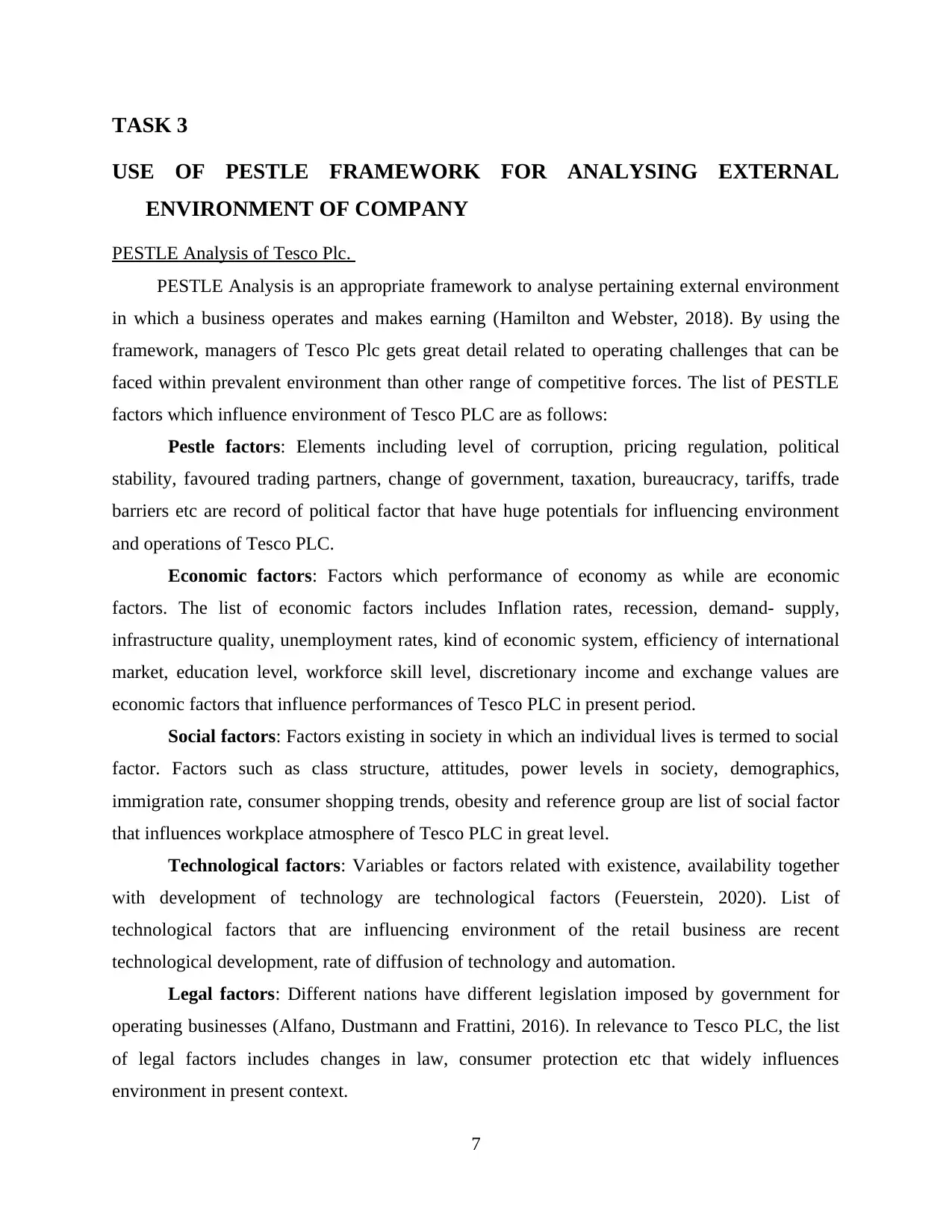
TASK 3
USE OF PESTLE FRAMEWORK FOR ANALYSING EXTERNAL
ENVIRONMENT OF COMPANY
PESTLE Analysis of Tesco Plc.
PESTLE Analysis is an appropriate framework to analyse pertaining external environment
in which a business operates and makes earning (Hamilton and Webster, 2018). By using the
framework, managers of Tesco Plc gets great detail related to operating challenges that can be
faced within prevalent environment than other range of competitive forces. The list of PESTLE
factors which influence environment of Tesco PLC are as follows:
Pestle factors: Elements including level of corruption, pricing regulation, political
stability, favoured trading partners, change of government, taxation, bureaucracy, tariffs, trade
barriers etc are record of political factor that have huge potentials for influencing environment
and operations of Tesco PLC.
Economic factors: Factors which performance of economy as while are economic
factors. The list of economic factors includes Inflation rates, recession, demand- supply,
infrastructure quality, unemployment rates, kind of economic system, efficiency of international
market, education level, workforce skill level, discretionary income and exchange values are
economic factors that influence performances of Tesco PLC in present period.
Social factors: Factors existing in society in which an individual lives is termed to social
factor. Factors such as class structure, attitudes, power levels in society, demographics,
immigration rate, consumer shopping trends, obesity and reference group are list of social factor
that influences workplace atmosphere of Tesco PLC in great level.
Technological factors: Variables or factors related with existence, availability together
with development of technology are technological factors (Feuerstein, 2020). List of
technological factors that are influencing environment of the retail business are recent
technological development, rate of diffusion of technology and automation.
Legal factors: Different nations have different legislation imposed by government for
operating businesses (Alfano, Dustmann and Frattini, 2016). In relevance to Tesco PLC, the list
of legal factors includes changes in law, consumer protection etc that widely influences
environment in present context.
7
USE OF PESTLE FRAMEWORK FOR ANALYSING EXTERNAL
ENVIRONMENT OF COMPANY
PESTLE Analysis of Tesco Plc.
PESTLE Analysis is an appropriate framework to analyse pertaining external environment
in which a business operates and makes earning (Hamilton and Webster, 2018). By using the
framework, managers of Tesco Plc gets great detail related to operating challenges that can be
faced within prevalent environment than other range of competitive forces. The list of PESTLE
factors which influence environment of Tesco PLC are as follows:
Pestle factors: Elements including level of corruption, pricing regulation, political
stability, favoured trading partners, change of government, taxation, bureaucracy, tariffs, trade
barriers etc are record of political factor that have huge potentials for influencing environment
and operations of Tesco PLC.
Economic factors: Factors which performance of economy as while are economic
factors. The list of economic factors includes Inflation rates, recession, demand- supply,
infrastructure quality, unemployment rates, kind of economic system, efficiency of international
market, education level, workforce skill level, discretionary income and exchange values are
economic factors that influence performances of Tesco PLC in present period.
Social factors: Factors existing in society in which an individual lives is termed to social
factor. Factors such as class structure, attitudes, power levels in society, demographics,
immigration rate, consumer shopping trends, obesity and reference group are list of social factor
that influences workplace atmosphere of Tesco PLC in great level.
Technological factors: Variables or factors related with existence, availability together
with development of technology are technological factors (Feuerstein, 2020). List of
technological factors that are influencing environment of the retail business are recent
technological development, rate of diffusion of technology and automation.
Legal factors: Different nations have different legislation imposed by government for
operating businesses (Alfano, Dustmann and Frattini, 2016). In relevance to Tesco PLC, the list
of legal factors includes changes in law, consumer protection etc that widely influences
environment in present context.
7
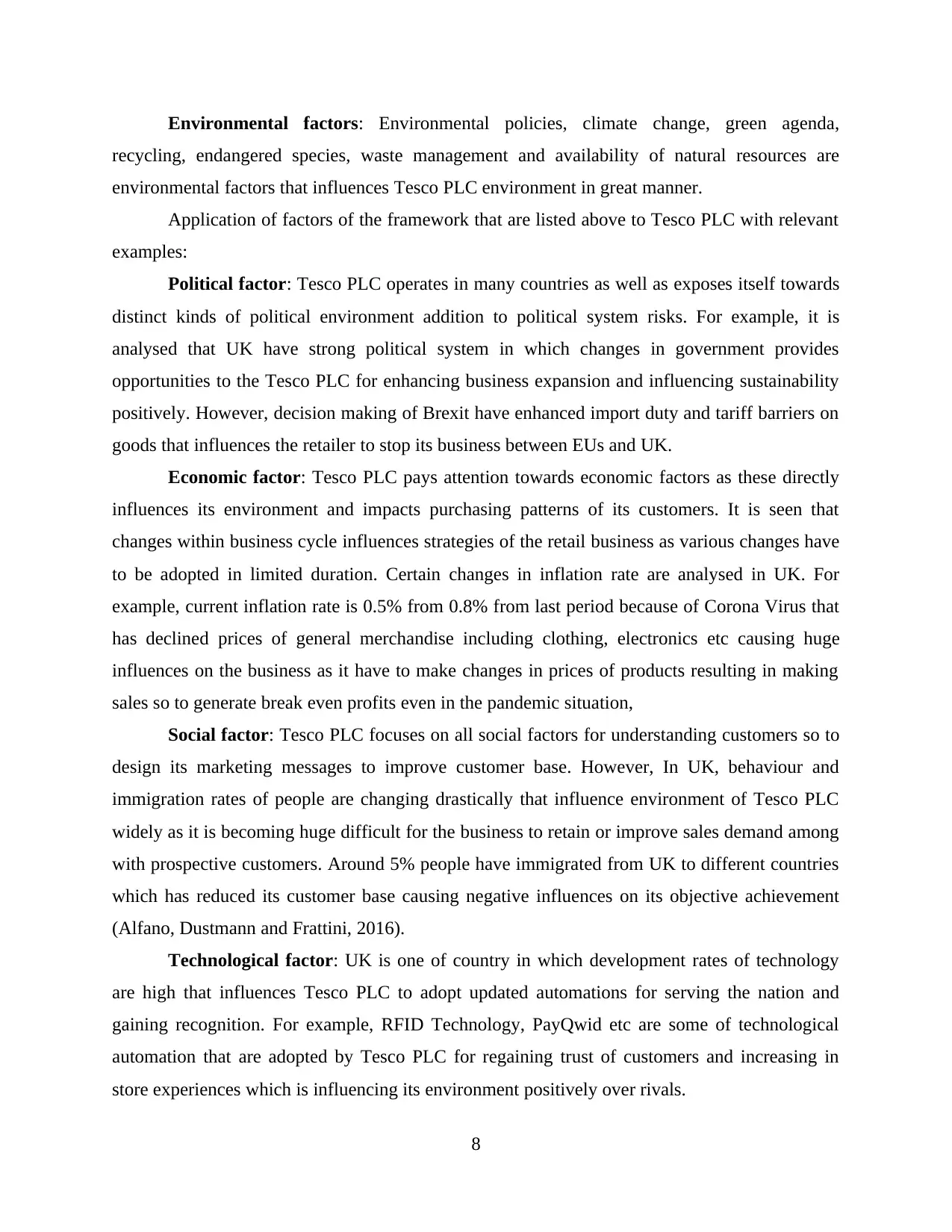
Environmental factors: Environmental policies, climate change, green agenda,
recycling, endangered species, waste management and availability of natural resources are
environmental factors that influences Tesco PLC environment in great manner.
Application of factors of the framework that are listed above to Tesco PLC with relevant
examples:
Political factor: Tesco PLC operates in many countries as well as exposes itself towards
distinct kinds of political environment addition to political system risks. For example, it is
analysed that UK have strong political system in which changes in government provides
opportunities to the Tesco PLC for enhancing business expansion and influencing sustainability
positively. However, decision making of Brexit have enhanced import duty and tariff barriers on
goods that influences the retailer to stop its business between EUs and UK.
Economic factor: Tesco PLC pays attention towards economic factors as these directly
influences its environment and impacts purchasing patterns of its customers. It is seen that
changes within business cycle influences strategies of the retail business as various changes have
to be adopted in limited duration. Certain changes in inflation rate are analysed in UK. For
example, current inflation rate is 0.5% from 0.8% from last period because of Corona Virus that
has declined prices of general merchandise including clothing, electronics etc causing huge
influences on the business as it have to make changes in prices of products resulting in making
sales so to generate break even profits even in the pandemic situation,
Social factor: Tesco PLC focuses on all social factors for understanding customers so to
design its marketing messages to improve customer base. However, In UK, behaviour and
immigration rates of people are changing drastically that influence environment of Tesco PLC
widely as it is becoming huge difficult for the business to retain or improve sales demand among
with prospective customers. Around 5% people have immigrated from UK to different countries
which has reduced its customer base causing negative influences on its objective achievement
(Alfano, Dustmann and Frattini, 2016).
Technological factor: UK is one of country in which development rates of technology
are high that influences Tesco PLC to adopt updated automations for serving the nation and
gaining recognition. For example, RFID Technology, PayQwid etc are some of technological
automation that are adopted by Tesco PLC for regaining trust of customers and increasing in
store experiences which is influencing its environment positively over rivals.
8
recycling, endangered species, waste management and availability of natural resources are
environmental factors that influences Tesco PLC environment in great manner.
Application of factors of the framework that are listed above to Tesco PLC with relevant
examples:
Political factor: Tesco PLC operates in many countries as well as exposes itself towards
distinct kinds of political environment addition to political system risks. For example, it is
analysed that UK have strong political system in which changes in government provides
opportunities to the Tesco PLC for enhancing business expansion and influencing sustainability
positively. However, decision making of Brexit have enhanced import duty and tariff barriers on
goods that influences the retailer to stop its business between EUs and UK.
Economic factor: Tesco PLC pays attention towards economic factors as these directly
influences its environment and impacts purchasing patterns of its customers. It is seen that
changes within business cycle influences strategies of the retail business as various changes have
to be adopted in limited duration. Certain changes in inflation rate are analysed in UK. For
example, current inflation rate is 0.5% from 0.8% from last period because of Corona Virus that
has declined prices of general merchandise including clothing, electronics etc causing huge
influences on the business as it have to make changes in prices of products resulting in making
sales so to generate break even profits even in the pandemic situation,
Social factor: Tesco PLC focuses on all social factors for understanding customers so to
design its marketing messages to improve customer base. However, In UK, behaviour and
immigration rates of people are changing drastically that influence environment of Tesco PLC
widely as it is becoming huge difficult for the business to retain or improve sales demand among
with prospective customers. Around 5% people have immigrated from UK to different countries
which has reduced its customer base causing negative influences on its objective achievement
(Alfano, Dustmann and Frattini, 2016).
Technological factor: UK is one of country in which development rates of technology
are high that influences Tesco PLC to adopt updated automations for serving the nation and
gaining recognition. For example, RFID Technology, PayQwid etc are some of technological
automation that are adopted by Tesco PLC for regaining trust of customers and increasing in
store experiences which is influencing its environment positively over rivals.
8
Secure Best Marks with AI Grader
Need help grading? Try our AI Grader for instant feedback on your assignments.
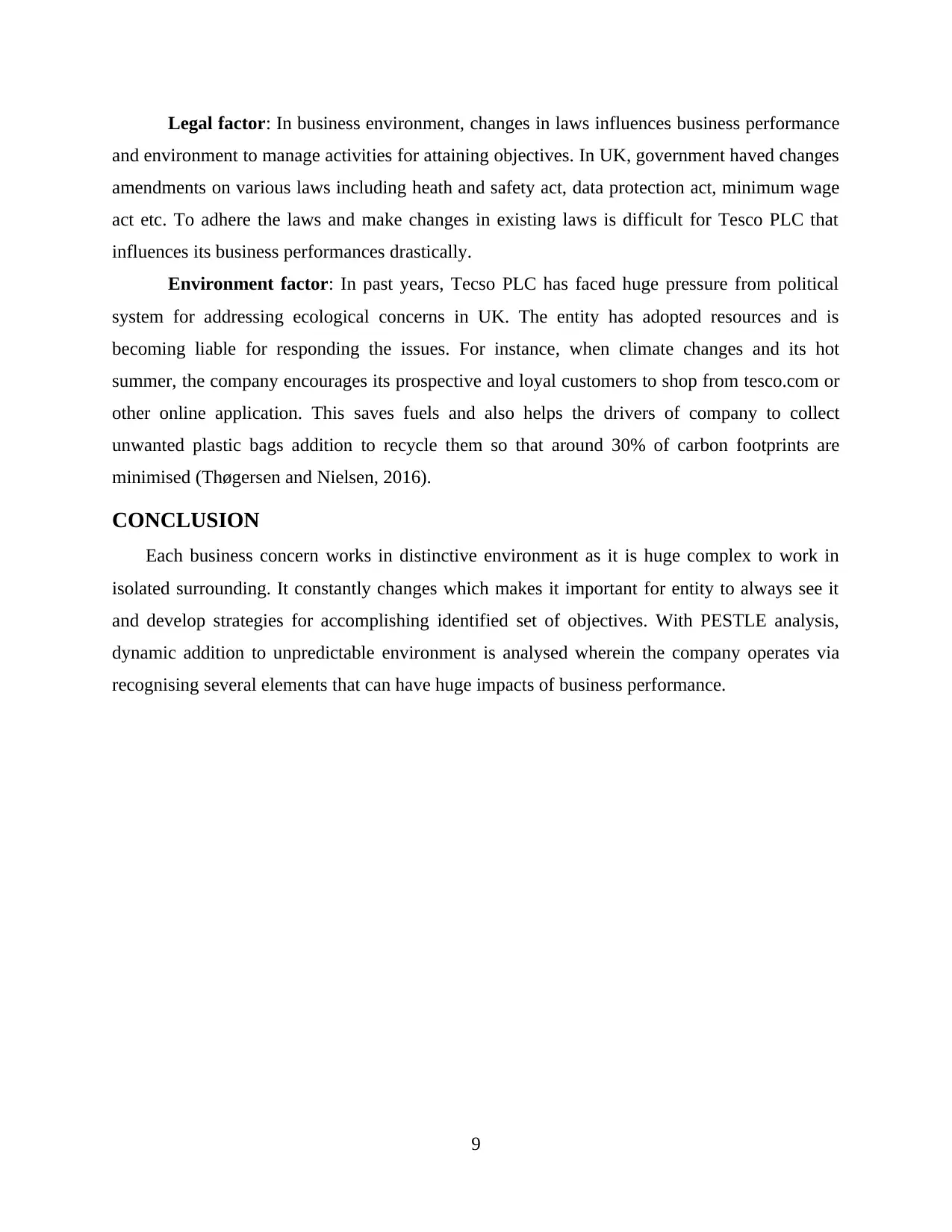
Legal factor: In business environment, changes in laws influences business performance
and environment to manage activities for attaining objectives. In UK, government haved changes
amendments on various laws including heath and safety act, data protection act, minimum wage
act etc. To adhere the laws and make changes in existing laws is difficult for Tesco PLC that
influences its business performances drastically.
Environment factor: In past years, Tecso PLC has faced huge pressure from political
system for addressing ecological concerns in UK. The entity has adopted resources and is
becoming liable for responding the issues. For instance, when climate changes and its hot
summer, the company encourages its prospective and loyal customers to shop from tesco.com or
other online application. This saves fuels and also helps the drivers of company to collect
unwanted plastic bags addition to recycle them so that around 30% of carbon footprints are
minimised (Thøgersen and Nielsen, 2016).
CONCLUSION
Each business concern works in distinctive environment as it is huge complex to work in
isolated surrounding. It constantly changes which makes it important for entity to always see it
and develop strategies for accomplishing identified set of objectives. With PESTLE analysis,
dynamic addition to unpredictable environment is analysed wherein the company operates via
recognising several elements that can have huge impacts of business performance.
9
and environment to manage activities for attaining objectives. In UK, government haved changes
amendments on various laws including heath and safety act, data protection act, minimum wage
act etc. To adhere the laws and make changes in existing laws is difficult for Tesco PLC that
influences its business performances drastically.
Environment factor: In past years, Tecso PLC has faced huge pressure from political
system for addressing ecological concerns in UK. The entity has adopted resources and is
becoming liable for responding the issues. For instance, when climate changes and its hot
summer, the company encourages its prospective and loyal customers to shop from tesco.com or
other online application. This saves fuels and also helps the drivers of company to collect
unwanted plastic bags addition to recycle them so that around 30% of carbon footprints are
minimised (Thøgersen and Nielsen, 2016).
CONCLUSION
Each business concern works in distinctive environment as it is huge complex to work in
isolated surrounding. It constantly changes which makes it important for entity to always see it
and develop strategies for accomplishing identified set of objectives. With PESTLE analysis,
dynamic addition to unpredictable environment is analysed wherein the company operates via
recognising several elements that can have huge impacts of business performance.
9
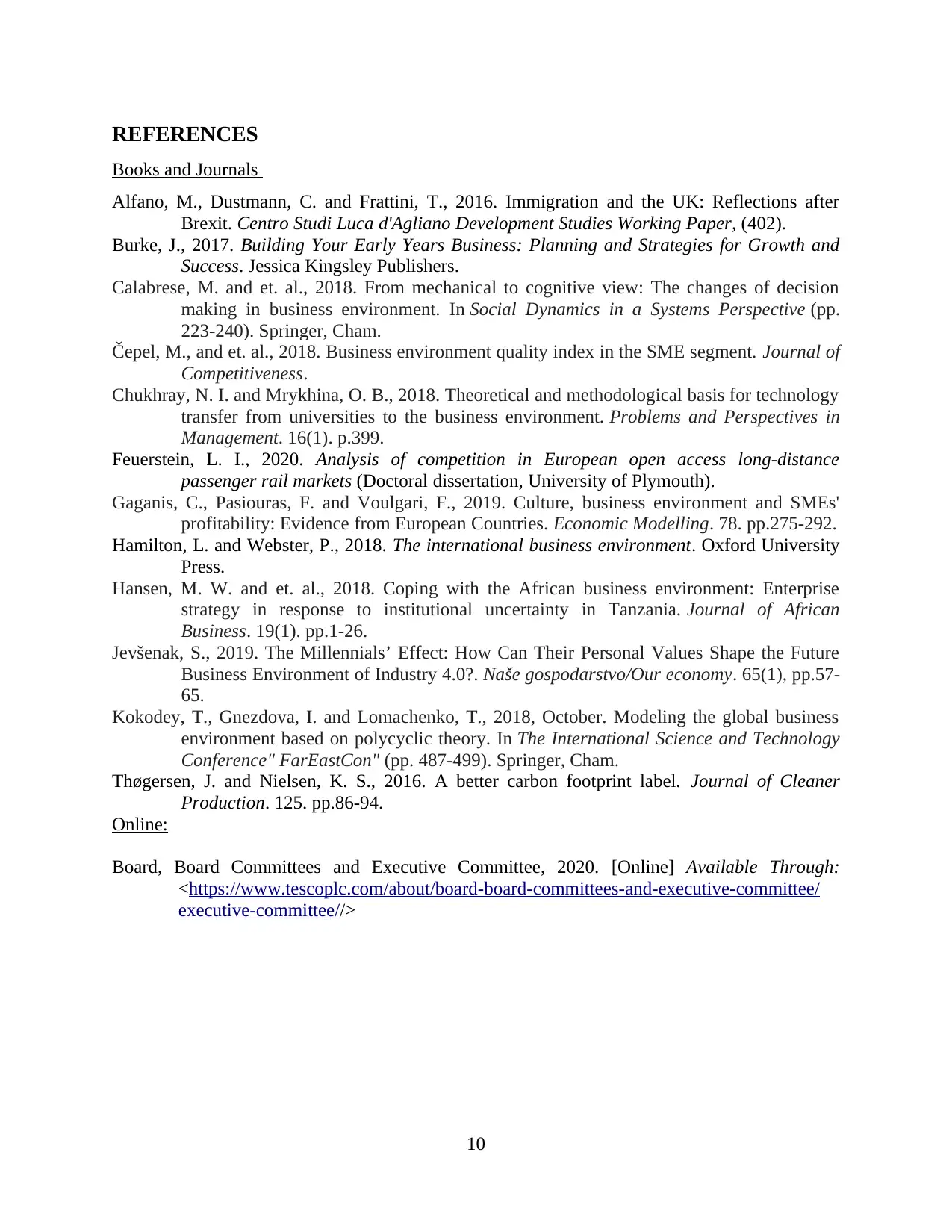
REFERENCES
Books and Journals
Alfano, M., Dustmann, C. and Frattini, T., 2016. Immigration and the UK: Reflections after
Brexit. Centro Studi Luca d'Agliano Development Studies Working Paper, (402).
Burke, J., 2017. Building Your Early Years Business: Planning and Strategies for Growth and
Success. Jessica Kingsley Publishers.
Calabrese, M. and et. al., 2018. From mechanical to cognitive view: The changes of decision
making in business environment. In Social Dynamics in a Systems Perspective (pp.
223-240). Springer, Cham.
Čepel, M., and et. al., 2018. Business environment quality index in the SME segment. Journal of
Competitiveness.
Chukhray, N. I. and Mrykhina, O. B., 2018. Theoretical and methodological basis for technology
transfer from universities to the business environment. Problems and Perspectives in
Management. 16(1). p.399.
Feuerstein, L. I., 2020. Analysis of competition in European open access long-distance
passenger rail markets (Doctoral dissertation, University of Plymouth).
Gaganis, C., Pasiouras, F. and Voulgari, F., 2019. Culture, business environment and SMEs'
profitability: Evidence from European Countries. Economic Modelling. 78. pp.275-292.
Hamilton, L. and Webster, P., 2018. The international business environment. Oxford University
Press.
Hansen, M. W. and et. al., 2018. Coping with the African business environment: Enterprise
strategy in response to institutional uncertainty in Tanzania. Journal of African
Business. 19(1). pp.1-26.
Jevšenak, S., 2019. The Millennials’ Effect: How Can Their Personal Values Shape the Future
Business Environment of Industry 4.0?. Naše gospodarstvo/Our economy. 65(1), pp.57-
65.
Kokodey, T., Gnezdova, I. and Lomachenko, T., 2018, October. Modeling the global business
environment based on polycyclic theory. In The International Science and Technology
Conference" FarEastСon" (pp. 487-499). Springer, Cham.
Thøgersen, J. and Nielsen, K. S., 2016. A better carbon footprint label. Journal of Cleaner
Production. 125. pp.86-94.
Online:
Board, Board Committees and Executive Committee, 2020. [Online] Available Through:
<https://www.tescoplc.com/about/board-board-committees-and-executive-committee/
executive-committee//>
10
Books and Journals
Alfano, M., Dustmann, C. and Frattini, T., 2016. Immigration and the UK: Reflections after
Brexit. Centro Studi Luca d'Agliano Development Studies Working Paper, (402).
Burke, J., 2017. Building Your Early Years Business: Planning and Strategies for Growth and
Success. Jessica Kingsley Publishers.
Calabrese, M. and et. al., 2018. From mechanical to cognitive view: The changes of decision
making in business environment. In Social Dynamics in a Systems Perspective (pp.
223-240). Springer, Cham.
Čepel, M., and et. al., 2018. Business environment quality index in the SME segment. Journal of
Competitiveness.
Chukhray, N. I. and Mrykhina, O. B., 2018. Theoretical and methodological basis for technology
transfer from universities to the business environment. Problems and Perspectives in
Management. 16(1). p.399.
Feuerstein, L. I., 2020. Analysis of competition in European open access long-distance
passenger rail markets (Doctoral dissertation, University of Plymouth).
Gaganis, C., Pasiouras, F. and Voulgari, F., 2019. Culture, business environment and SMEs'
profitability: Evidence from European Countries. Economic Modelling. 78. pp.275-292.
Hamilton, L. and Webster, P., 2018. The international business environment. Oxford University
Press.
Hansen, M. W. and et. al., 2018. Coping with the African business environment: Enterprise
strategy in response to institutional uncertainty in Tanzania. Journal of African
Business. 19(1). pp.1-26.
Jevšenak, S., 2019. The Millennials’ Effect: How Can Their Personal Values Shape the Future
Business Environment of Industry 4.0?. Naše gospodarstvo/Our economy. 65(1), pp.57-
65.
Kokodey, T., Gnezdova, I. and Lomachenko, T., 2018, October. Modeling the global business
environment based on polycyclic theory. In The International Science and Technology
Conference" FarEastСon" (pp. 487-499). Springer, Cham.
Thøgersen, J. and Nielsen, K. S., 2016. A better carbon footprint label. Journal of Cleaner
Production. 125. pp.86-94.
Online:
Board, Board Committees and Executive Committee, 2020. [Online] Available Through:
<https://www.tescoplc.com/about/board-board-committees-and-executive-committee/
executive-committee//>
10
1 out of 12
Related Documents
Your All-in-One AI-Powered Toolkit for Academic Success.
+13062052269
info@desklib.com
Available 24*7 on WhatsApp / Email
![[object Object]](/_next/static/media/star-bottom.7253800d.svg)
Unlock your academic potential
© 2024 | Zucol Services PVT LTD | All rights reserved.





